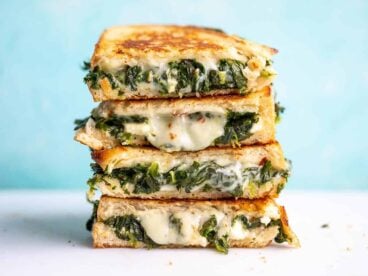
Our mission is to promote sustainable food sources and provide access to the highest quality ingredients with integrity. We aim to encourage healthy eating while bringing joy with beautiful plates full of flavourful dishes.
Whether it's from a family recipe or from a 5-star restaurant, we believe everyone should have the chance to experience delightful cuisine. If you would like to contribute your talents or stories on our blog please contact us at [email protected] - we'd love to hear from you!
With love from Belovedsaffron.com - Enjoy the journey!
Now love yourself and enjoy this one ...
I started making Turkey Pinwheels for my daughter (a picky eater) to make her meals a little more fun. It’s also a great way to sneak some extra wholesome ingredients into her lunch undetected. (Mom hack!) Since you can make the cream cheese spread in advance, this Turkey Pinwheel recipe is also perfect for meal prep! Pinwheels are also super versatile and make an affordable appetizer that’s easy to throw together for brunches, party buffets, and potlucks. It’s as simple as making a sandwich…but with a twist!
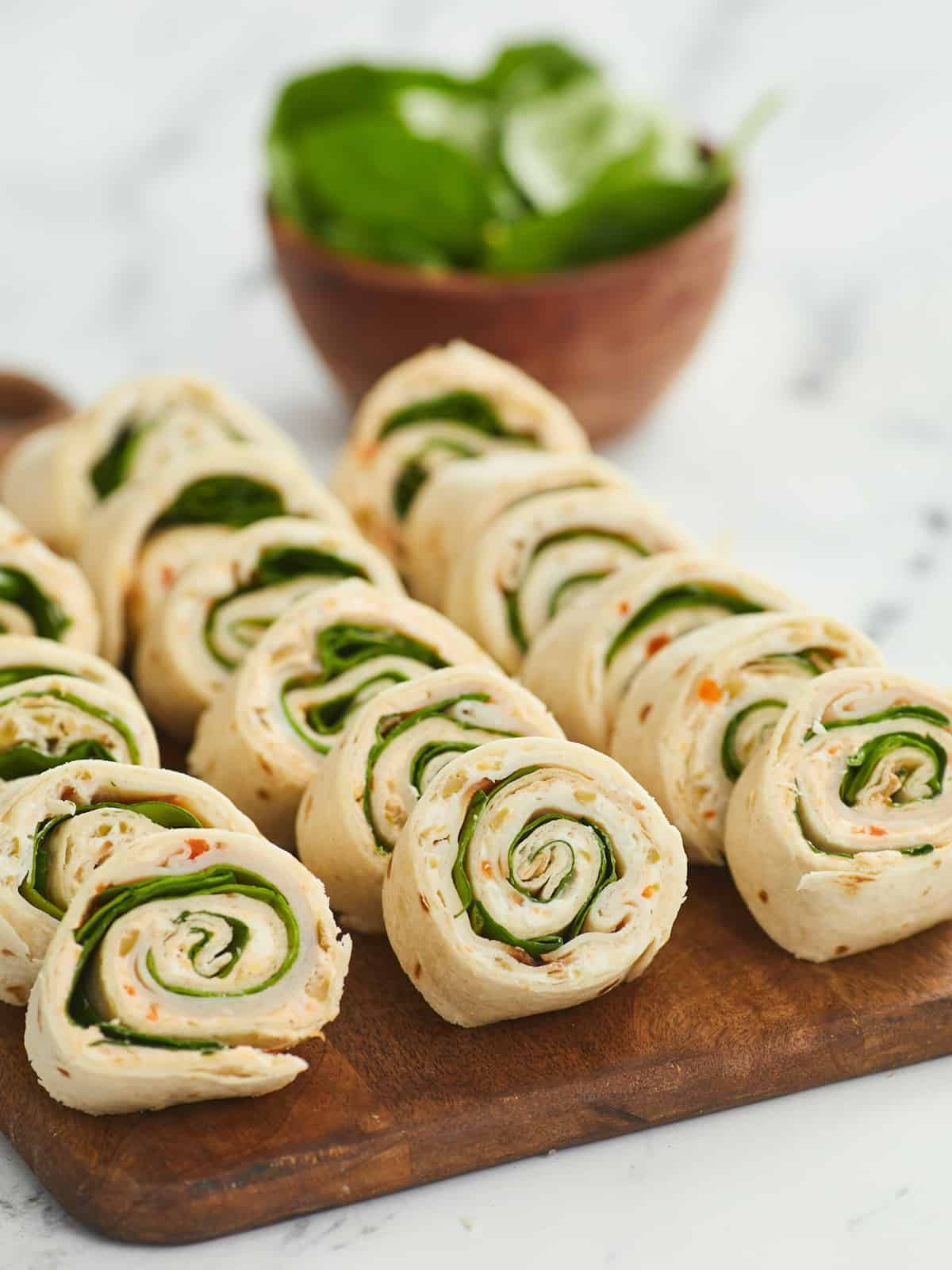
What are pinwheel sandwiches?
Turkey Pinwheels are made by evenly spreading cream cheese on one side of a flour tortilla (which acts as the glue), layering on classic sandwich ingredients, and then tightly rolling it all up into a log that’s sliced into 1” pieces. When each pinwheel is turned on its side, it will reveal a lovely spiral of the ingredients inside.
Pinwheel 101
Our simple recipe for Turkey Pinwheels uses deli meat, spinach, and a savory cream cheese spread inspired by pimento cheese. However, this is a super versatile recipe that can be made with many different combinations of ingredients. Here is what you need to make pinwheels:
- Extra-Large Flour Tortillas: Burrito-size flour tortillas are best for pinwheels. They’re easier to roll, make a distinct spiral, and yield more per tortilla. You can use any flavor (plain, wheat, spinach, sun-dried tomato, etc.). Since corn tortillas are less pliable and tear easily, they are not an ideal choice.
- A sticky spread: Typically, pinwheels are held together with cream cheese, but anything similar (like hummus or nut butter) can be used.
- Deli Meat: Pinwheels usually include some kind of deli meat (turkey, chicken, ham, salami, etc.), but that can also be replaced with thinly-sliced veggies.
- Cheese: Sliced cheeses are great for creating an added layer of filling. Shredded cheeses can be mixed in with cream cheese (like in our recipe) so they don’t fall out.
- Salad greens and other sandwich toppings: These will help to create color contrast in the pinwheel’s spiral, and round out the other rich ingredients with freshness and flavor!
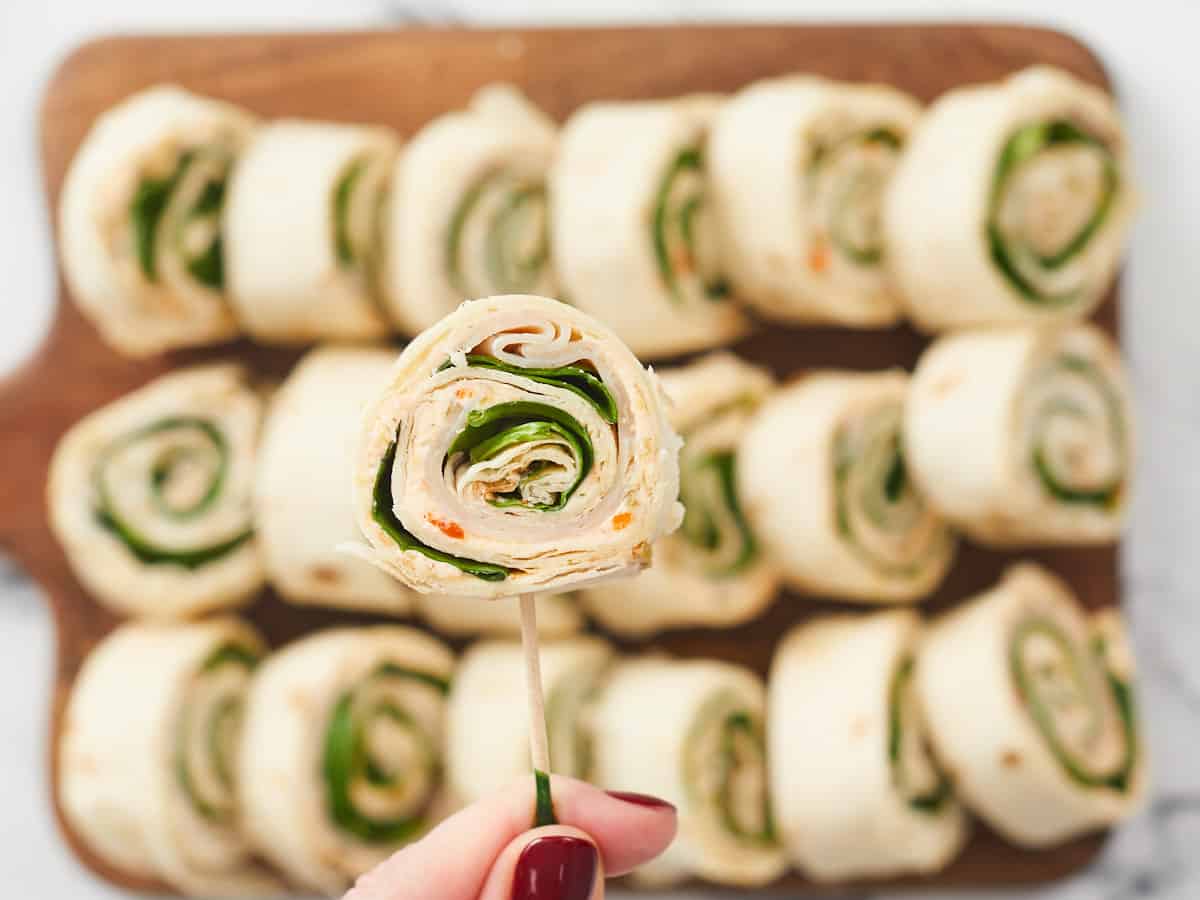
MORE PINWHEEL flavor COMBINATIONS TO TRY:
- Ham + swiss cheese + dill pickles + yellow mustard
- Salami + provolone cheese + iceberg lettuce + pepperoncinis
- Chicken + hummus + cucumber slices + tabbouleh
- Smoked salmon + red onion + capers + everything bagel seasoning
- Nut butter + honey + banana slices
- Nutella + toasted coconut + strawberry slices
CAN TURKEY PINWHEELS be made in advance?
Turkey Pinwheels are a great recipe to make ahead for a party or help fill the gaps in your weekly meal prep. The cream cheese spread can be kept in an air-tight container and refrigerated for about a week. Pre-made pinwheels will also keep in the fridge for 2-3 days before they start to get soggy.

Turkey Pinwheels
Equipment
- White Cutting Boards
- Chef’s Knife
Ingredients
- 4 oz. cream cheese, softened $1.10
- 2 Tbsp sharp cheddar cheese, finely shredded $0.87
- 1/3 cup pimento-stuffed olives, finely chopped $0.99
- 1 Tbsp olive brine
- 1/2 tsp garlic powder $0.05
- 1/4 tsp black pepper $0.01
- 4 extra-large or burrito-style flour tortillas $1.15
- 1 9oz. package sliced turkey $4.99
- 1 cup spinach $0.80
Instructions
- Stir together the softened cream cheese, finely-shredded cheddar cheese, finely-chopped pimento-stuffed olives, olive brine, garlic powder, and black pepper until very well combined.
- Lay the tortillas out flat. Spread 2-3 tablespoons of the cream cheese mixture on one side of each tortilla, coating the entire face evenly from edge to edge.
- Arrange 3-4 slices of turkey along the center of the tortilla, overlapping them as little as possible to make an even layer, and leaving about ¼” of the cream cheese spread exposed on the top and bottom edges of the tortilla to help it stick together. Then add a single layer of spinach leaves on top of the turkey.
- Starting with the edge closest to you, fold over the tortilla so it sticks, and then roll it up as tightly as possible, tucking in the fillings as you go.
- With the seam side facing down, slice the roll into 1" wide pieces.
- Flip each pinwheel on its face, exposing the spiral, and transfer it to a serving platter or air-tight meal prep container. The pinwheels should hold together on their own, but if desired, you can insert a decorative toothpick into each.
See how we calculate recipe costs here.
Nutrition
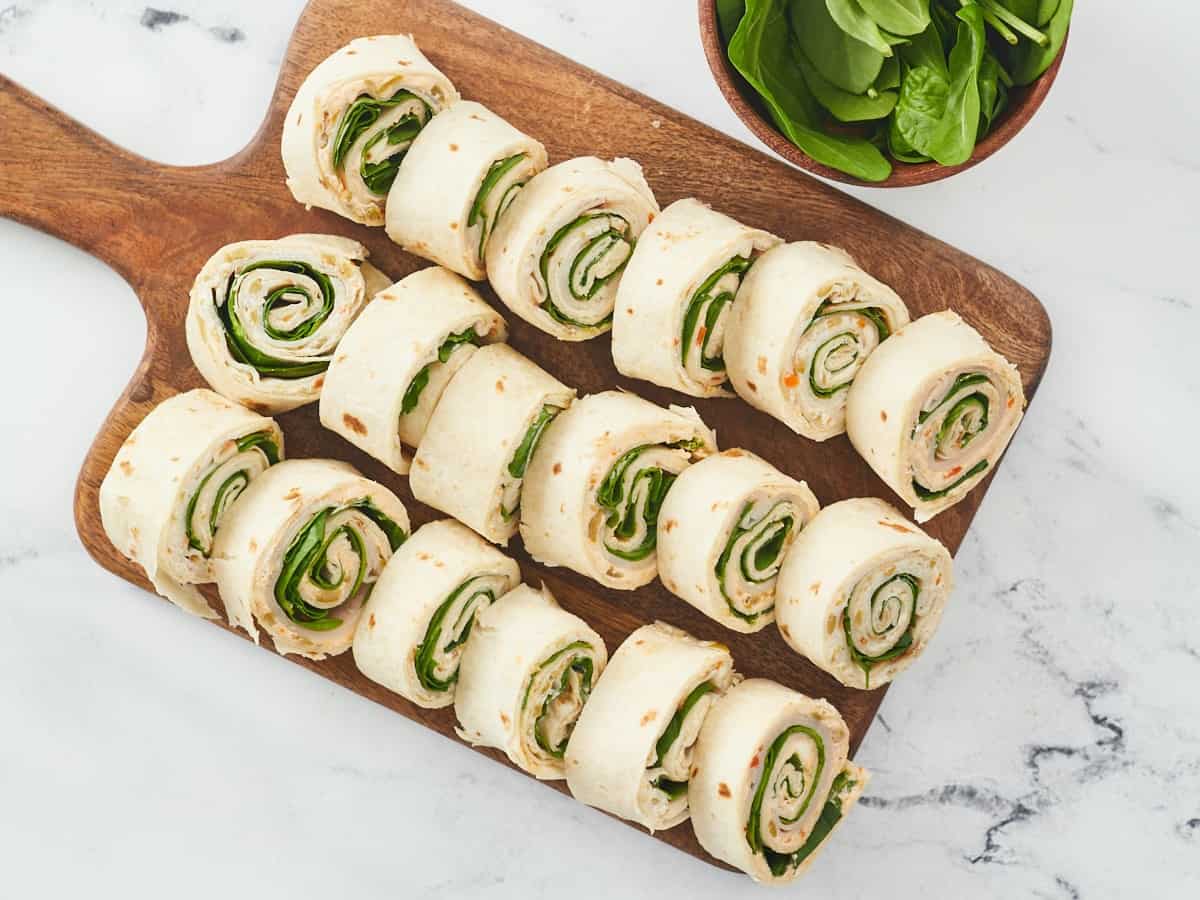
How to Make TuRKEY PINWHEELS - Step by Step Photos
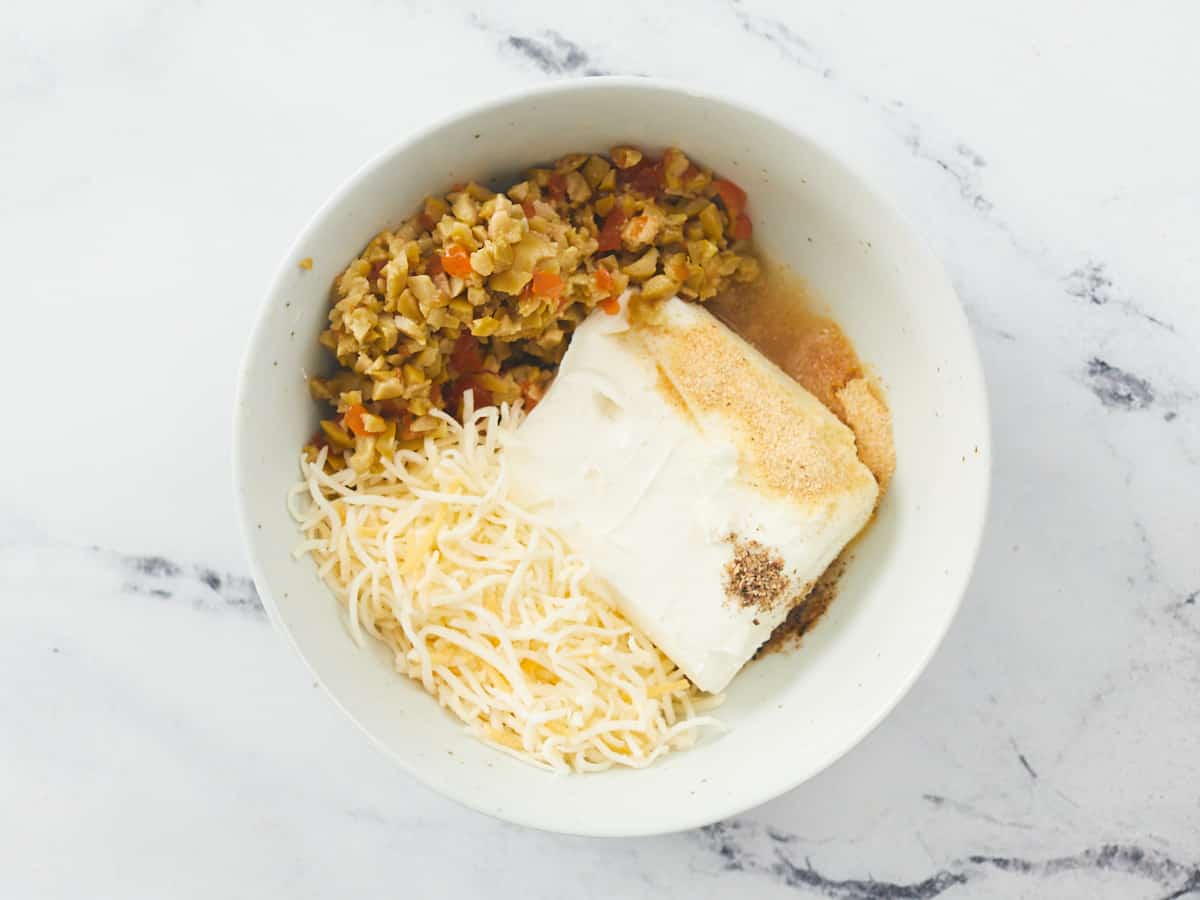
In a small bowl or air-tight container, make the cream cheese spread by stirring together 4 oz. of room-temperature cream cheese (cold cream cheese will be extremely difficult to mix and will likely create unpleasant lumps in the mixture), 1/8 cup of finely-shredded cheddar cheese, 1/3 cup of finely-chopped pimento-stuffed olives, 1 tablespoon of olive brine (which helps thin the cream cheese and eliminates the need for added salt), 1/2 teaspoon garlic powder, and 1/4 teaspoon of pepper until very well mixed.
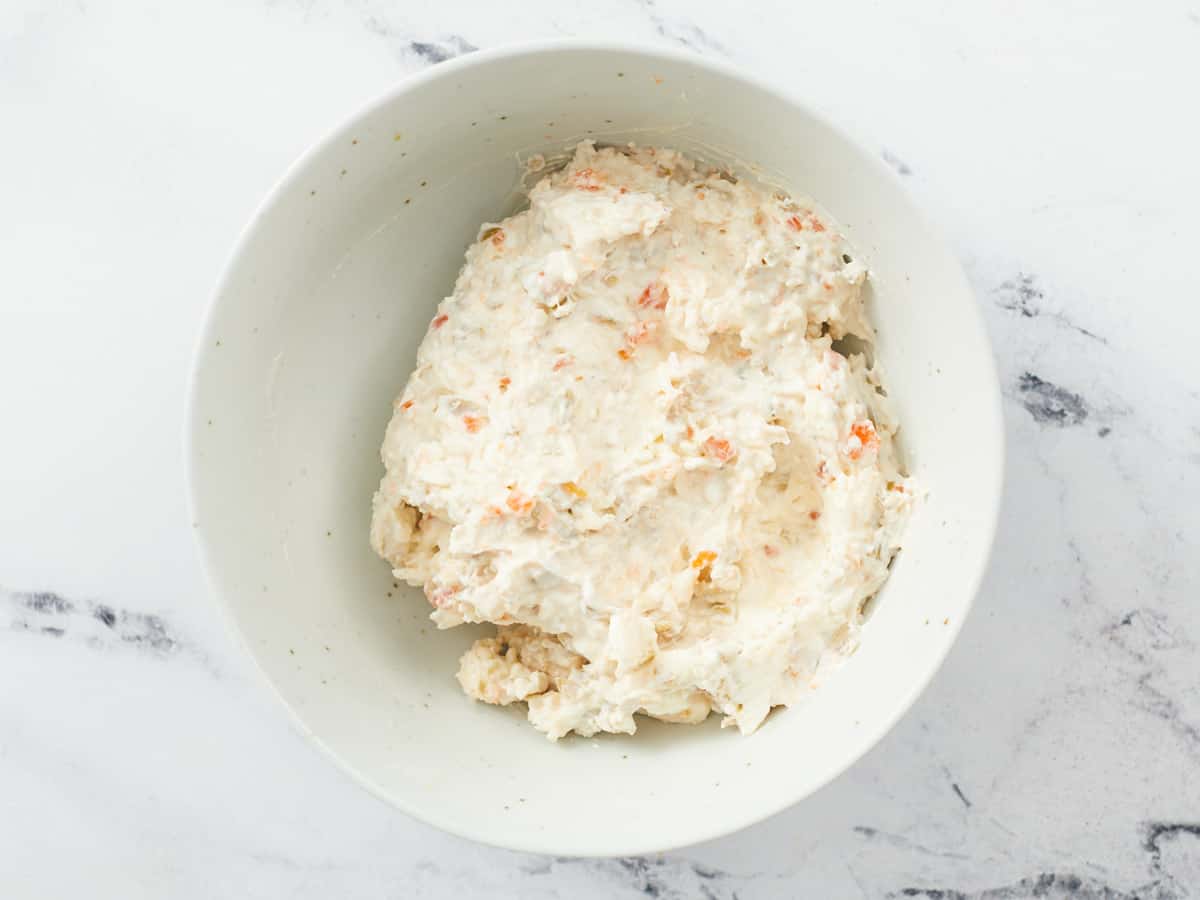
This savory cream cheese spread, which is inspired by pimento cheese dip, can be made ahead and kept refrigerated for at least a week. If coming from the fridge, you will want to re-soften this mixture at room temperature (for about 30 minutes) before trying to spread it on the tortillas in the following step.
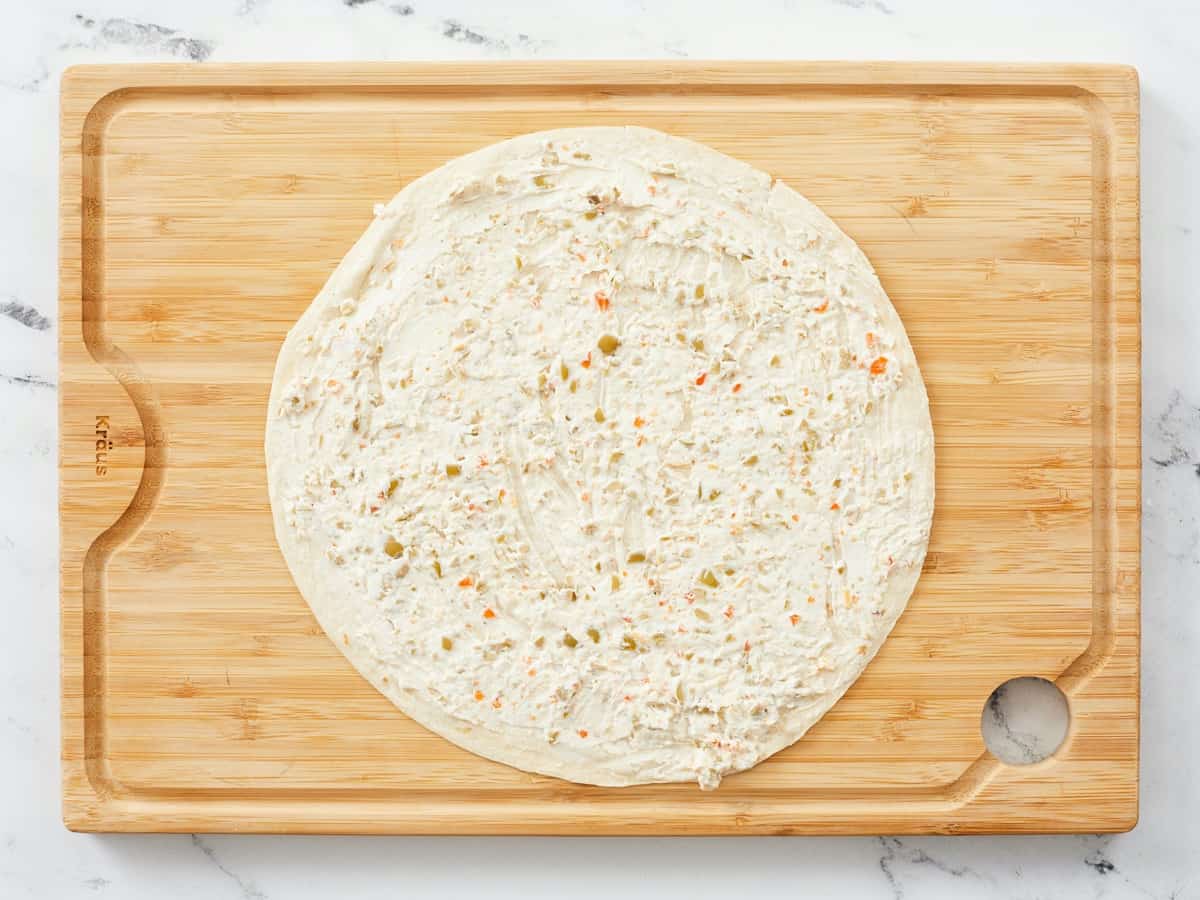
Lay each tortilla out flat on a clean work surface, and spread each tortilla with 2-3 tablespoons (about 1/4 of the mixture) of the savory cream cheese spread, covering it evenly from edge to edge. You can always add a bit more “glue” as you roll (or after slicing) if needed, but it’s much easier to do at this step.
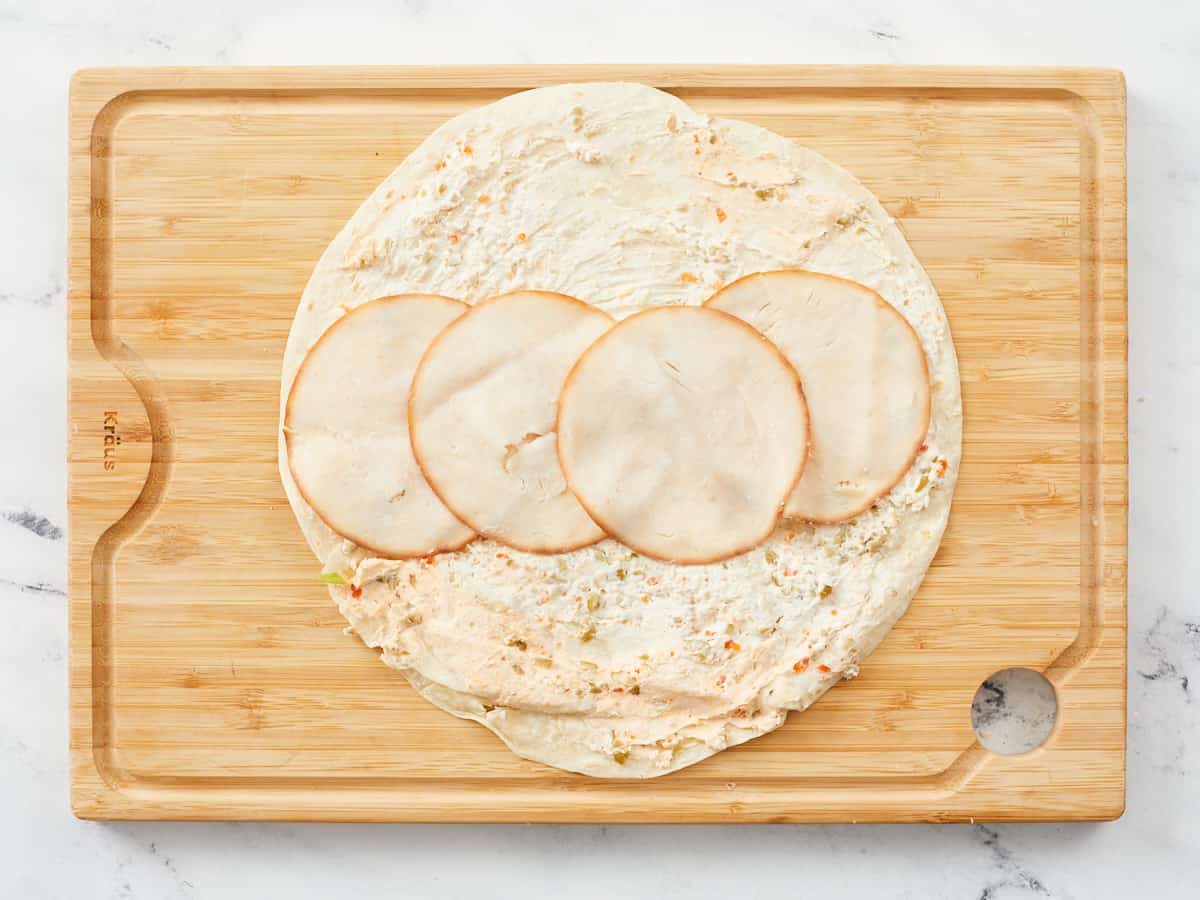
Arrange 3-4 slices of turkey across the center of the tortilla, overlapping them slightly to make an even layer depending on the size and thickness of each slice. (Since ours were super thin, we overlapped the slices more so each bite was still as satisfying!)
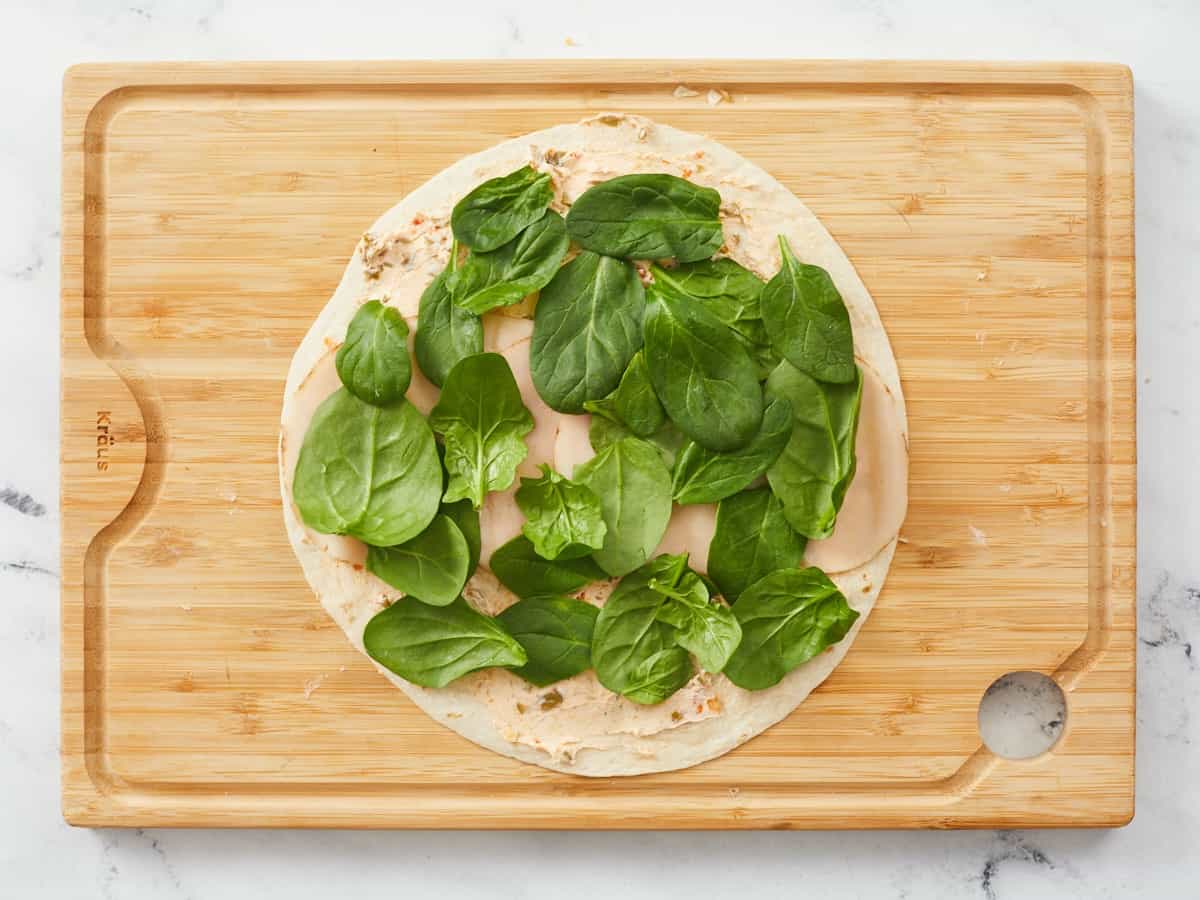
Add a single layer of spinach leaves on top of the turkey, leaving about ¼” of the cream cheese spread exposed along the top and bottom edges of the tortilla so it will stick properly. I usually like to take the extra step of removing the longer stems.
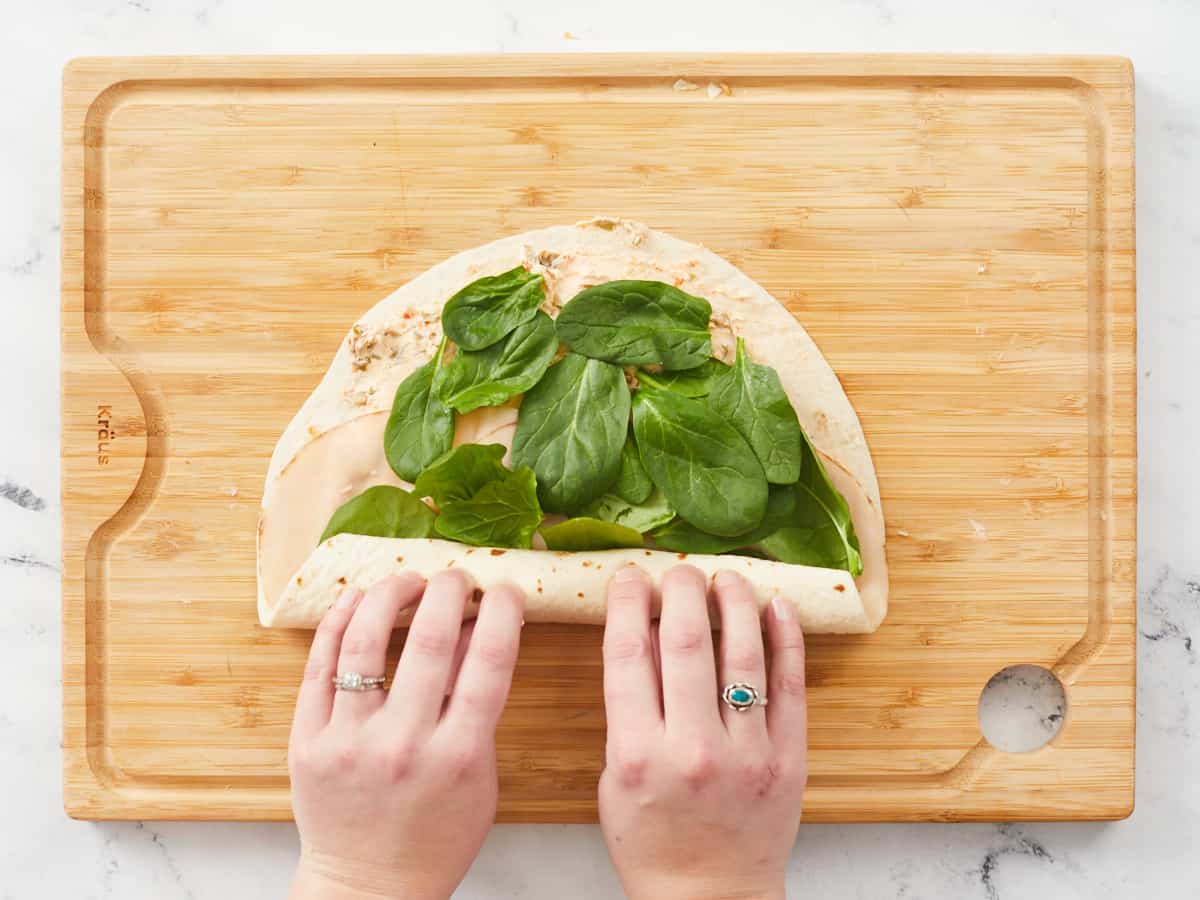
Starting with the end closest to you, fold in the edge of the tortilla so it sticks, and then roll it all the way up, as tightly as possible, tucking and rearranging the fillings as you go — just to make sure you get a little bit of everything in every bite!
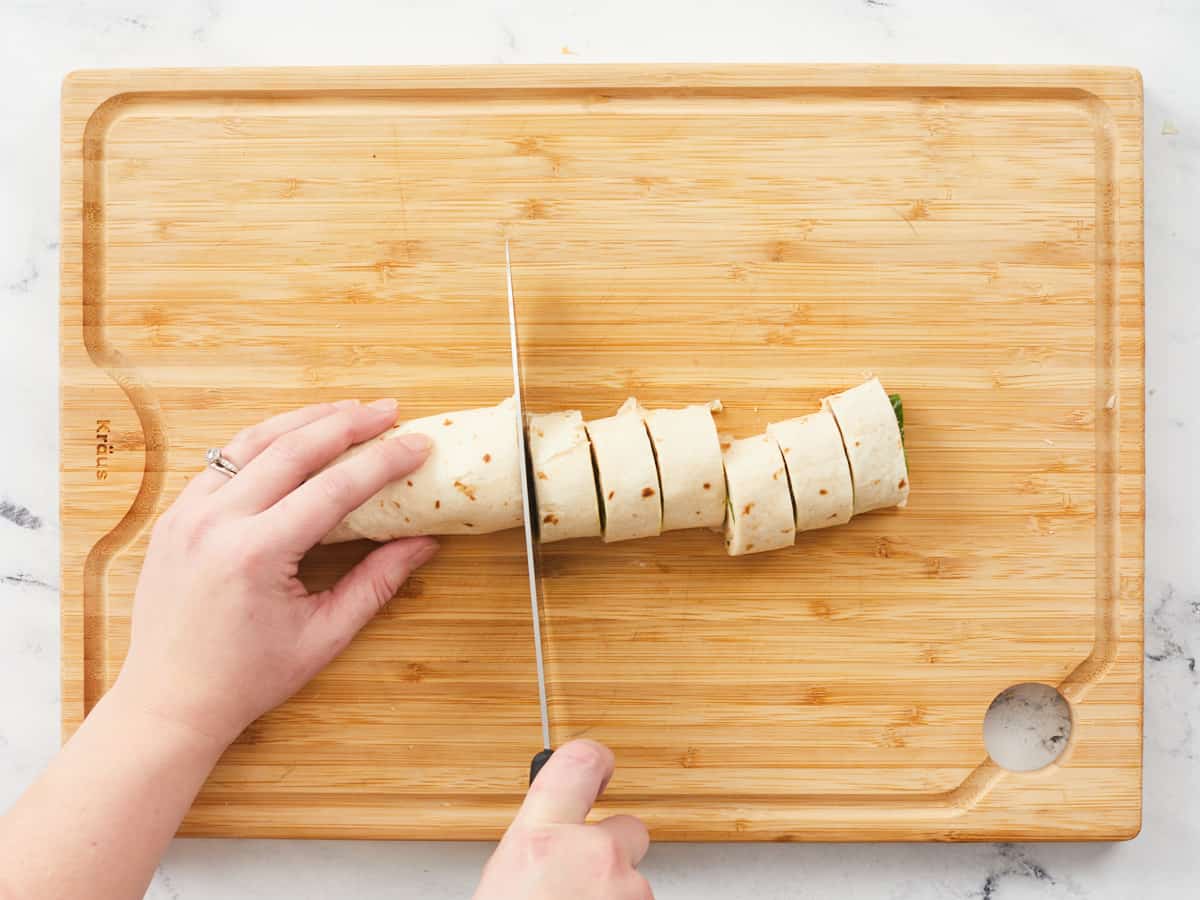
Adjust the log so that the exposed seam is secured against the cutting board before slicing it. Then, using a very sharp knife, slice the log into 8 even portions (about 1” wide). Be as gentle as possible, so the pinwheels maintain their shape as much as possible and the filling doesn’t squish out. To help, you can rotate the log as you slice, or just use a good knife and adjust them all here and there after slicing (as I have done!)
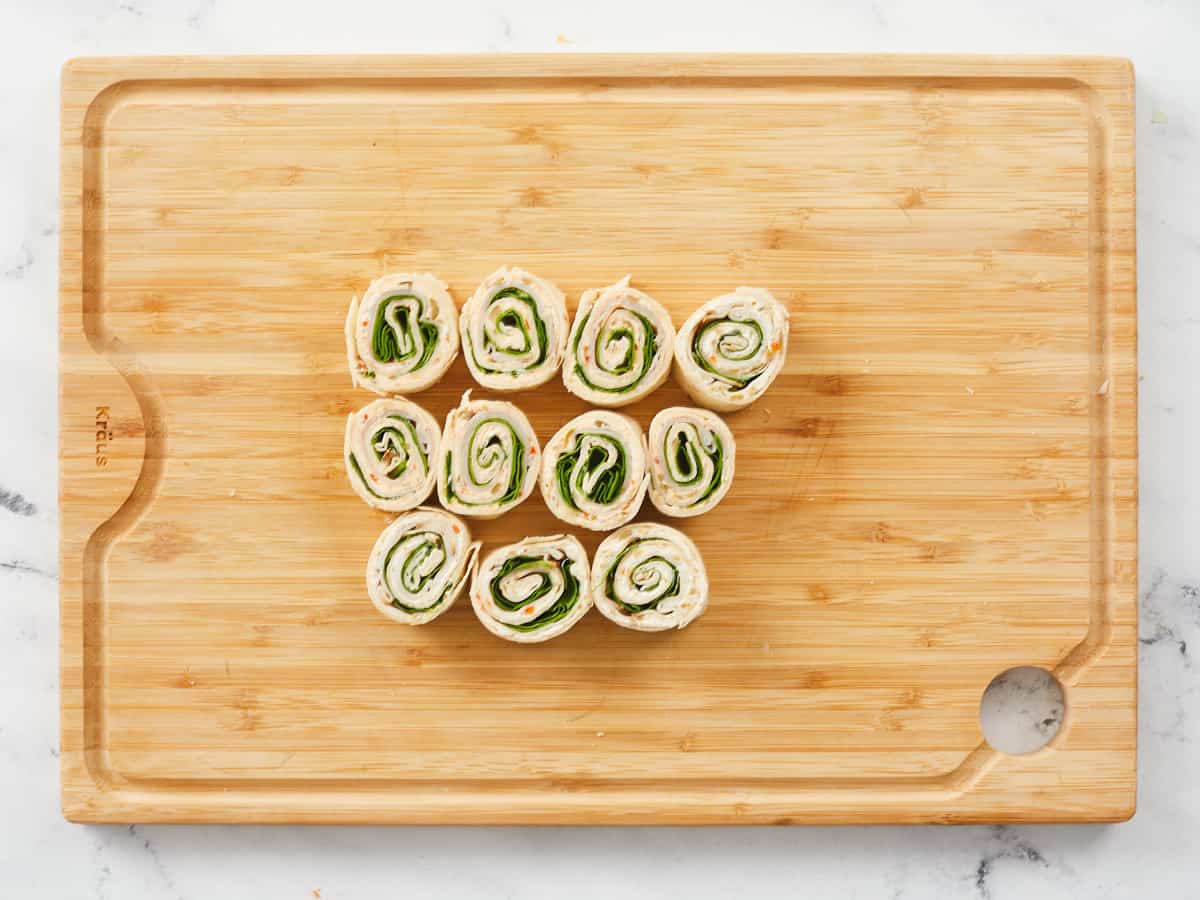
Flip each pinwheel on its face, exposing the spiral, and transfer to a serving platter or air-tight container. The pinwheels should hold together on their own, but if desired, you can insert a decorative toothpick into each pinwheel, starting with the outermost edge, to ensure they won’t unravel.
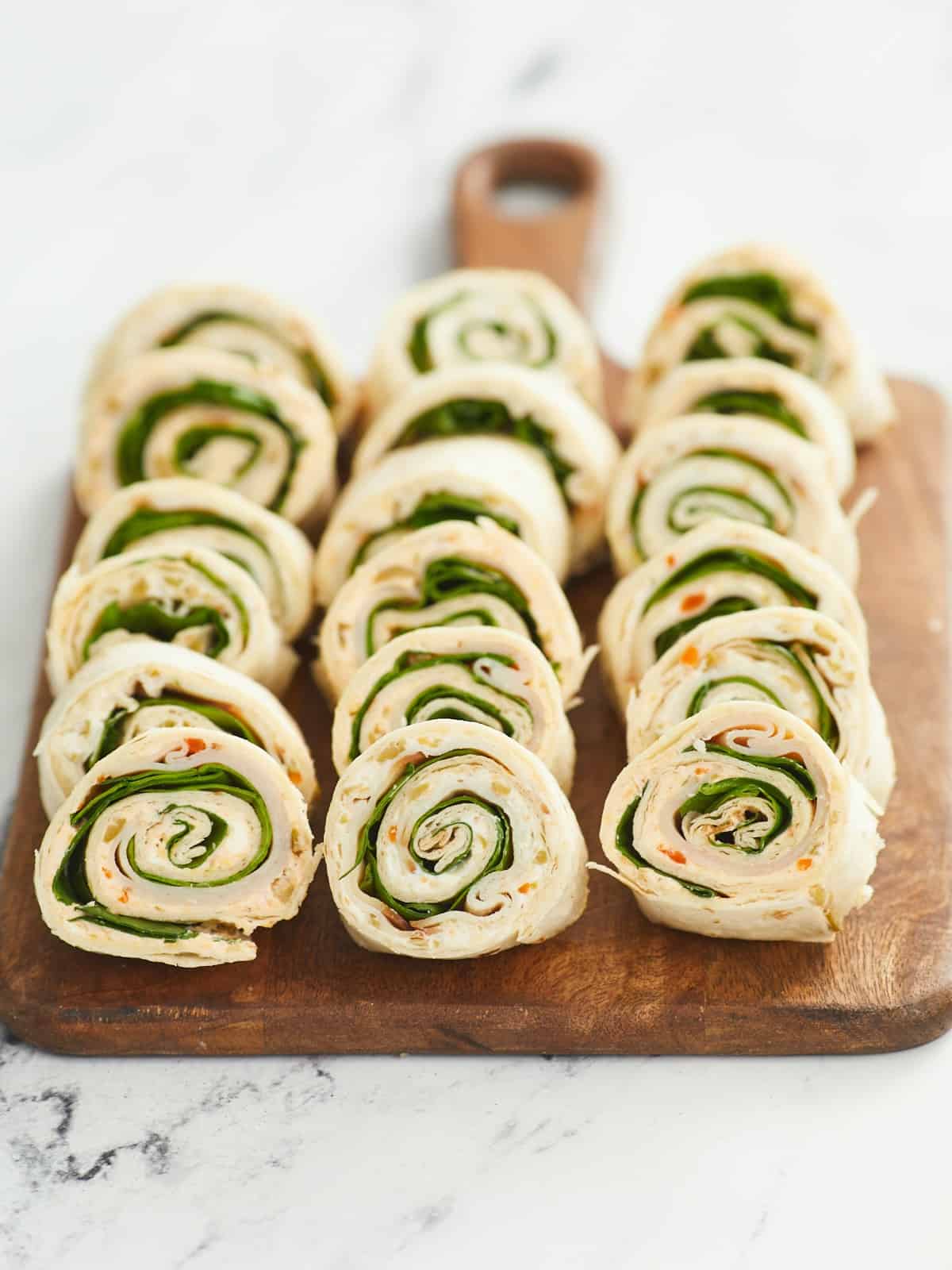
MORE EASY SANDWICH RECIPES

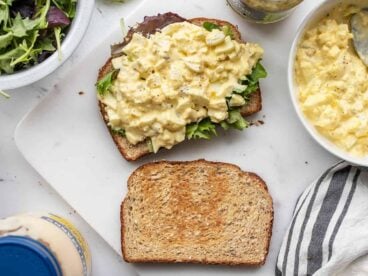
Easy Egg Salad

How to Make the Best Veggie Sandwich
The post Turkey Pinwheels appeared first on Budget Bytes.
By: Marion - Budget BytesTitle: Turkey Pinwheels
Sourced From: www.budgetbytes.com/turkey-pinwheels/
Published Date: Wed, 08 Feb 2023 17:21:12 +0000
Frequently Asked Questions
Which herbs are healing herbs?
If you look for healing herbs, you won’t find them in the supermarket. There isn’t any place to buy them. There is no store selling them.
You haven’t been able to find healing herbs because they aren’t sold anywhere. They are grown right here in our backyard.
Healing herbs are plants that grow naturally in North America. Like many common household items, these herbs grow throughout the United States and Canada.
These herbs treat minor ailments such as colds, flu, sore throats, coughs, and headaches. Many of these herbs have been used for centuries to help heal wounds and promote overall health.
Of course, when we say “heal,” we mean more than simply treating an illness. We also refer to the ability of these herbs to restore balance and harmony within ourselves and the world around us.
For example, the chamomile herb helps relieve stress. This means that if you feel stressed out, you may benefit from taking chamomile tea. Chamomile tea has been shown to reduce anxiety and nervous tension.
In addition, chamomile tea has been proven effective in relieving insomnia.
Chamomile tea has many other benefits, including its ability to ease stomach aches and gas pains and even improve digestion.
Another popular healing herb is Echinacea. Echinacea is known for helping to fight infections and boosting the immune system.
Echinacea is commonly taken internally and externally to fight infection, prevent viral diseases, and boost immunity. It is safe to use during pregnancy and lactation.
Echinacea also helps reduce muscle pain and inflammation. You can take echinacea orally or topically (as an ointment).
This herb is available in both liquid and capsule form. Liquid echinacea is often mixed with honey and lemon juice. The mixture is then strained and consumed.
Capsules are usually made of freeze-dried plant material. They contain standardized amounts of active ingredients. To use capsules, swallow one or two a day.
The third type of herbal remedy is called tincture. Tinctures are alcoholic extracts of herbs. They are typically used to treat internal problems. Tinctures are generally diluted before being ingested.
Tinctures can be taken orally or applied topically. For oral consumption, dilute tinctures with water. Some people prefer to mix tinctures with food.
Tinctures are easy to prepare. Put about one tablespoon of dried herb into a bottle containing enough alcohol to cover the herb completely. Allow the mixture to sit for several weeks. Then strain and consume.
You may want to try some of these natural remedies to see which ones work best.
What are the disadvantages of using herbs?
Herbs are a great way to keep your body healthy because they contain vitamins, minerals, antioxidants, enzymes, amino acids, phytonutrients, polyphenols, flavonoids, terpenes, essential oils, carotenoids, sterols, and sterolins. Some even contain cannabinoids.
But there are also lots of side effects associated with herbal remedies. For example, taking too much herb could cause liver damage or even death. Herbal supplements may interact with prescription drugs, which means that they might affect how well the drug works.
Some herbs can interfere with blood clotting, while others may increase bleeding when taken with anticoagulants (blood thinners).
There are also safety concerns for pregnant women and children.
The bottom line is that herbs aren't safe for everyone. If you're considering trying them out, do your homework. Look up each product's side effects and warnings and read reviews online.
What is the difference between basil and oregano?
Both of these herbs belong to the Lamiaceae family. They share similar flavors, but the differences are obvious.
Oregano is more pungent than basil. It also adds an extra layer of flavor to foods.
Basil leaves are smaller than oregano leaves. They are also softer and less aromatic.
The two herbs are often used interchangeably. Although they are quite similar, each has its distinctive qualities.
What herb heals all wounds?
The answer to this question varies depending on the type and severity of the wound.
The herb comfrey (also known as knitbone) has long been used for its healing properties, particularly for skin injuries such as cuts and bruises.
Studies suggest that comfrey contains allantoin, which helps speed up healing. Other herbs commonly used for healing wounds include calendula, plantain, and yarrow. These herbs help to reduce inflammation, stop bleeding and speed up the skin's healing process.
In addition to herbs, honey has also been found to have powerful antimicrobial properties that can help prevent wound infection.
Herbs for wound care is an age-old practice that continues to be used today. However, herbs should not replace medical treatment, and always consult your doctor before using herbs for healing. With the right herbs, you can give your body the support it needs to heal naturally.
Which spices from the kitchen are used to cure diseases?
There are more than 4000 medicinal plants that are widely distributed throughout the world. Some of these plants contain active compounds that may help treat various ailments.
In India alone, there are more than 1000 species of herbs that are used for medical purposes. This includes Ayurvedic medicine, Unani medicine, Siddha medicine, Homeopathic medicine, and Chinese medicine.
The most common ingredient found in these medicines is ginger. Ginger contains volatile oils that give it its aromatic flavor. These oils contain anti-inflammatory properties that make them useful against arthritis, fever, vomiting, and indigestion.
Ginger also helps relieve nausea and stomach cramps caused due to pregnancy. Pregnant women often consume ginger tea to reduce morning sickness. Ginger is also commonly used for cough and cold relief.
Another spice that is known to have medicinal value is turmeric. Turmeric contains curcumin which has been shown to inhibit tumor growth. This makes it an effective cancer treatment.
Turmeric is also considered to be very beneficial for joint health. It relieves inflammation and stiffness associated with rheumatoid arthritis. It is also believed to prevent osteoporosis.
Garlic, too, is another herb that is extensively used in traditional medicine. Its healing qualities include treating infections, asthma, heart disease, and diabetes and even reducing cholesterol levels. Garlic oil is also used to treat wounds and insect bites.
Garlic is a natural antibiotic that fights bacteria and viruses. The antibacterial property makes it ideal for treating respiratory tract infections such as bronchitis and pneumonia.
It is also helpful in preventing urinary tract infections.
Other spices like cinnamon, cloves, nutmeg, cardamom, black pepper, ginger, cayenne, mustard seeds, fennel, and coriander are also used to treat different illnesses.
What are healing flowers?
Healing flowers are plants that promote peace and tranquillity. They help us unwind after a stressful day and make us feel more relaxed.
They also help us connect to our inner selves and reconnect with nature.
These beautiful blooms are used for meditation, prayer, and contemplation.
We call hundreds of varieties of flowering plants ‘healing’ because they provide such a fantastic experience.
This list includes roses, lilies, irises, daffodils, peonies, tulips, hyacinths, and many more.
But there are two species that I find particularly special. These are the Geranium and Lilium.
Geraniums are very easy to grow and come in various colors. Liliums are also known as lily-of-the-valley, which means 'lily' and 'valley.' Both of these species are popular garden flowers.
Healing flowers are often found growing near water. They are said to bring peace and calmness to those who meditate with them.
In ancient times, people would light candles in flower petals to symbolize the sun. This way, they could honor the sun without needing to go outdoors.
Some say that when you look at these flowers, you may see angels dancing.
What herbs should you take daily?
Depending on your health and wellness needs, many herbs can be taken daily to help improve your overall health.
Popular herbs for daily consumption include ashwagandha, turmeric, ginger, holy basil, chamomile, lavender, peppermint, and cayenne pepper. Ashwagandha is an adaptogenic herb that can help the body resist stress and anxiety. Turmeric is known for its anti-inflammatory properties, while ginger has been shown to aid digestion and boost immunity. Holy basil may help with managing blood sugar levels, as well as providing a calming effect. Chamomile can promote relaxation, while lavender is used in aromatherapy for its calming properties. Peppermint can help aid digestion and reduce nausea, while cayenne pepper has antibacterial properties that may boost your immunity.
As always, you must consult your doctor before taking herbs daily to ensure they are safe for you and do not interact with any other medications or herbs you may be taking.
There is no shortage of information on what foods we should eat and how much exercise we should do. But when it comes to what supplements we should take, there is a dearth of knowledge.
This is because most of us aren’t sure which ones work or which are junk. So we go online and look up whatever we can find.
But often, these articles are written by companies trying to promote their products. Which means they're usually biased toward their product.
So instead of finding unbiased advice, we end up reading marketing hype.
This makes sense since marketers make more money selling stuff than doctors.
The medical industry isn’t even allowed to advertise directly to consumers anymore. The best way to learn about natural remedies is to read independent reviews.
This is where you'll find real users sharing their experiences with each supplement. These sites give you an honest opinion of whether or not a particular herb helps.
Users will often share their experience with a supplement after taking it. This gives you a good idea of its effectiveness and any side effects.
You can also check out forums dedicated to herbalism. Here you can ask questions and receive answers based on personal experience.
Of course, there are plenty of other ways to learn about herbs.
There are books, websites, blogs, videos, podcasts, and classes. All of them provide valuable information about natural remedies.
Statistics
- The global herbs market is expected to reach more than $125 billion by the end of 2025.
- Herbs are among the most popular and widely used medicinal remedies. According to a survey conducted by the National Institutes of Health, herbs were used by over 38% of adults in the United States.
External Links
amazon.com
ncbi.nlm.nih.gov
- Antioxidant capacity of 26 spice extracts and characterization of their phenolic constituents - PubMed
- Cinnamon: A Multifaceted Medicinal Plant - PMC
doi.org
sciencedirect.com
- Peppermint oil (Mintoil®) in the treatment of irritable bowel syndrome: A prospective, double-blind placebo-controlled randomized trial
- Curcumin reverses the effects of chronic stress on behavior, the HPA axis, BDNF expression, and phosphorylation of CREB
How To
How to Use Herbs and Spices in Cooking?
Herbs and spices are a great way to add flavor without adding calories. If you've been cooking for years, you already know how easy it is to make even bland foods taste delicious. Try these tips to add more flair to your dishes.
Herbs and spices are essential ingredients in any kitchen. In addition to making food taste better, they also help keep food fresh longer. From enhancing the flavors of soups and sauces to infusing drinks with exotic tastes, herbs and spices go far beyond traditional cooking.
The most important thing to remember when using herbs and spices is to use them sparingly. Even though they may seem like powerful ingredients, they have a strong scent. So, sprinkle them on top instead of piling them onto a dish.
You'll find that the best herbs and spices come in small containers. This makes them easier to measure out, so there won't be any waste. Plus, you'll save money because you won't have to buy large amounts.
Another tip is to avoid placing herbs and spices directly on hot pans. Heat will quickly dry out the herbs and spices, leaving a bitter aftertaste. Instead, place them on paper towels to absorb excess moisture.
Use herbs and spices liberally in recipes where they naturally complement each other. For example, cinnamon pairs well with apples, while garlic complements tomatoes. Once you learn how to combine flavors, you'll be able to create your signature dishes.
Try experimenting with different herbs and spices to spice up meals. For instance, mix thyme, rosemary, oregano, and basil in a bowl. Add salt and pepper to taste. Then toss the mixture with pasta, chicken, or fish.
After the meal, store leftover herbs and spices in airtight jars. This will prevent them from drying out. Also, wrap unused herbs and spices tightly in plastic wrap. They should stay fresh for at least three months.
If you're looking for ways to improve your diet, consider trying new herbs and spices. You can experiment with different blends until you discover your favorite combination. The possibilities are endless!
Did you miss our previous article...
https://belovedsaffron.com/recipes/stuffed-pepper-soup
.png)





